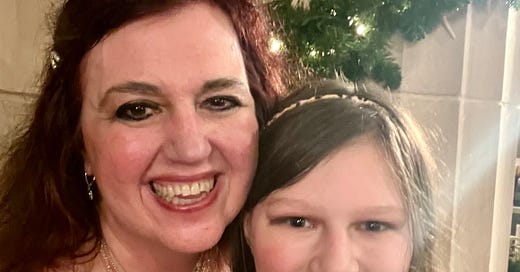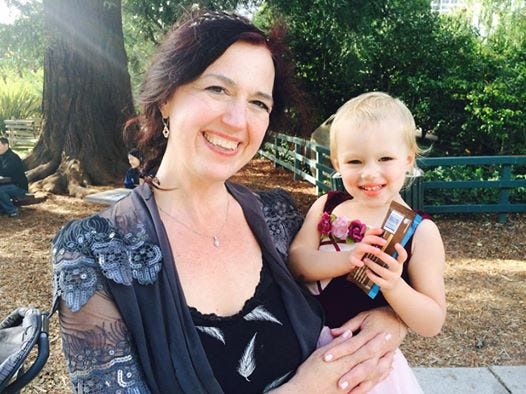Ten years ago this week, I took my daughter Mélanie, who had just turned two, to her first movie in a theatre. We’d just gone to The Nutcracker, which she loved, and she was starting to appreciate longer stories (photo above is us at Nutcracker last night, now a holiday tradition). It seemed like a good time to take Mélanie to her first movie in a theater. I’d heard a couple of interview on NPR with the writers and actors involved in a new Disney movie that was supposed to have heroines outside the traditional mold. We’ve seen it countless times since and loved it each time, we can sing the songs and have acted them out with various toys. We were Anna and Elsa on multiple Halloweens. But the first time we saw Frozen, with no expectations, was magical.
I’ve always loved fairy tales. The only Disney princesses in my childhood were Snow White, Cinderella, and Aurora (which definitely dates me). I liked all of them, had books and records (dating myself again) with their stories and was particularly attached to my Aurora and Phillip paper dolls. But from a young age I also always liked flawed heroines like Emma Woodhouse in Austen’s Emma or Barbara Childe in Heyer’s An Infamous Army or villainesses like Achren in Llyod Alexander’s Chronicles of Prydain or Milady de Winter in Dumas's The Three Musketeers. As I said in a blog post "for one thing (as I noticed as a child) they usually get to wear the best clothes :-) (only compare Emma with Fanny Price or Becky Sharp with Amelia or Milady with Constance)." But more seriously, I think it’s in large part that they often are characters who break rules and defy conventions. As a child, I liked them because they *did* things instead of waiting around to be rescued. Conventional heroines tend to be too perfect. Which tends also to go with a lack of inner conflict.
When I started writing, my favorite of my heroines tended to be those who pushed convention the most. Until I got to Mélanie Rannoch in my current series. French spy who married her husband to spy on him only to fall in love with him. Tormented by her divided loyalties, but still a realist about the compromises inherent in the life of a spy. Handy with a knife and a pistol. Adept at code breaking. Definitely flawed and conflicted, definitely a rule breaker, and definitely not the sort to wait around to be rescued. And she still keeps me guessing fears and books into the series. I’m never quite sure how far she’ll go. Neither is her husband—and neither is she.
That holiday season in 2013, Mélanie and I settled into seats with peppermint hot chocolate, and there was Anna, who is sweet but also human enough to make mistakes and brave enough to try to fix them and who saves herself by committing an act of love instead of being the passive recipient of a true love’s kiss. Anna is an interesting heroine in her own right. But she isn’t the one who sings that song, the song little girls were soon singing on countless playgrounds. Apparently Elsa was originally going to be a villain in the mold of Maleficent or Ursula or Snow White’s stepmother. Her character evolved as the movie was being made. In fact when "Let It Go" was first written, the song writers weren’t sure whether Elsa would be singing it as a heroine or a villainess. But instead of a wicked queen she ended up a Disney princess who is also a tortured heroine, struggling with her powers and her identity, trying to be perfect, facing the fact that she has to be herself.
Mélanie liked both Anna and Elsa growing. She had Anna and Elsa dolls and played with them together. The Halloweens we were Anna and Elsa, she wanted to be Anna and wanted me to be Elsa (photo above from the Halloween after we first saw Frozen). Now, at 12, she says Elsa is her favorite. We always saw far more Elsas than Annas out trick or treating. The Elsa toys were by far the hardest to find it stock. Mélanie sang all the songs from Frozen but she particularly loved to belt out “Let it Go.” “The perfect girl is gone” is a long way from “Someday my prince will come” or “Someday I’ll be part of your world". Ariel was one Mélanie's of other favorite Disney princesses along with Elena of Avalor. Lately for Halloween she’s been her own take on Mal from Descendants (who is probably as close as you can get to a Disney parallel for Mélanie Rannoch) (photo below from this Halloween).
No matter how ubiquitous “Let it Go” became, I never got tired of hearing my daughter sing it. Or of hearing it on our CD, or our video, or sung by her singing Elsa doll or her Frozen karaoke microphone… Mélanie was was singing “Let it Go” recently and we both agreed “The perfect girl is gone” is our favorite line. Characters are much more real and intersting when they aren’t perfect, but there’s more of a tradition of flawed heroes than flawed heroines. Mélanie now helps me plot and proofreads for me. And she’s writing her own stories. I hope my writer daughter Mélanie takes inspiration from Mélanie Rannoch and the other female characters in the series, including Laura Dudley, governess to the Rannoch children, who is also a spy; Cordelia Davenport, who betrays her husband as well, in a different way from Mélanie; Kitty Velasquez, who may be sharper-edged than Mélanie herself; and Lady Frances, who reigns at the heart of the beau monde but bends convention to her will rather than the other way round.
Do you remember when you first saw Frozen? Or are you one of the rare people who hasn’t seen it? What’s your favorite type of heroine?







I have never seen Frozen, but I agree with you that flawed heroines are more interesting--also more risky. I think most readers will give a hero a lot more slack for his shortcomings and wrong turns, while a heroine who stumbles gets the "too stupid to live," comment all too often. I do wonder if that's not a symptom of female readers being much too hard on themselves....?